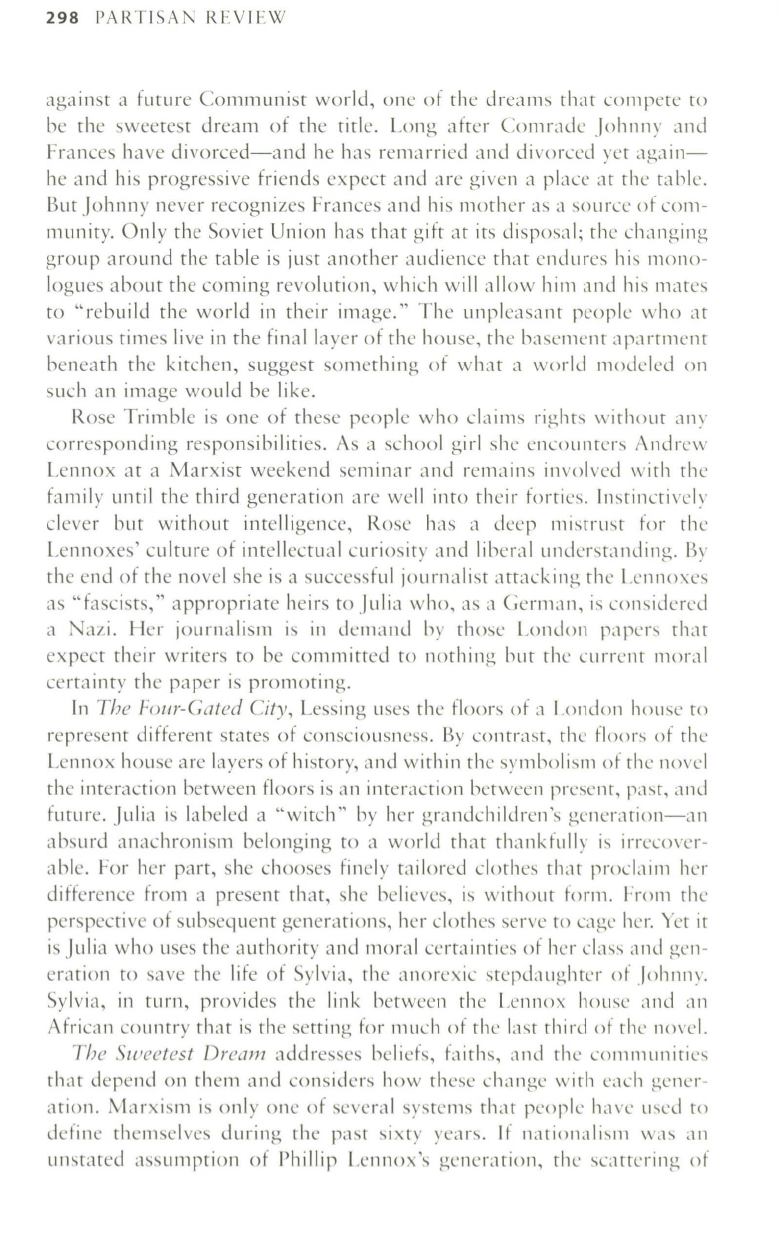
298
PARTISAN REVIEW
against a future Communist world, one of the dreams that compete
to
be the sweetest dream of the title. Long after Comrade Johnny and
Frances have divorced-and he has remarried and divorced yet again–
he and his progressive friends expect and are given a place at the table.
But Johnny never recognizes Frances and his mother as a source of com–
l11unity. Only the Soviet Union has that gift at its disposal; the changing
group around the table is just another audience th,H endures his mono–
logues about the coming revolution, which will allow him
,11lt.l
his mates
to
"rebuild the world in their image." The unpleasant people who at
various times live in the final layer of the house, the basement apartment
beneath the kitchen, suggest something of what a world modeled on
such an image would be like.
Rose Trimble is one of these people who claims rights without a
11\'
corresponding responsibilities. As a school girl she encounters Andrew
Lennox at a Marxist weekend seminar and remains involved with the
family until the third generation are well into their forties. Instinctively
clever but without intelligence, Rose has a deep mistrust for the
Lennoxes' culture of intellectual curiosity and liberal understanding. By
the end of the novel she is a successful journalist attacking the Lennoxes
as "fascists," appropriate heirs
to
Julia who, as a German, is considered
a azi. Her journalism is in demand hy those London papers that
expect their writers
to
be committed
to
nothing but the current moral
certainty the paper is promoting.
In
The Four-Gated City,
Lessing uses the floors of a London house
to
represent different states of consciousness. By contrast, the floors of the
Lennox house are layers of history, and within the symbolism of the novel
the interaction between floors is an interaction between present, past, and
future. Julia is labeled a "witch" by her grandchildren'S generation-an
absurd anachronism belonging
to
a world that thankfully is irrec()\'er–
able. For her parr, she chooses finely tailored clothes that proclaim her
difference from a present that, she believes, is without form. From the
perspective of subsequent generations, her clothes serve to cage her. Yet it
is Julia who uses the authority and
111
ora I certainties of her class and gen–
eration to save the life of Sylvia, the anorexic stepdaughter of Johnny.
Sylvia, in turn, provides the link between the Lennox house and an
African country that is the setting for much of the last third of the novel.
The Sweetest Dream
addresses beliefs, faiths, and the communities
that depend on them and considers how these change with each gener–
ation. Marxism is only one of several systems that people have used to
define themselves during the past sixty years.
If
nationalism was an
unstated assumption of Phillip Lennox's generation, the scattering of


